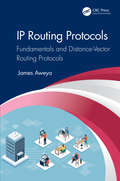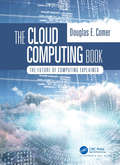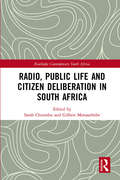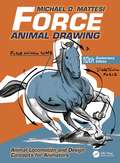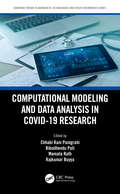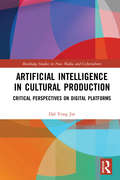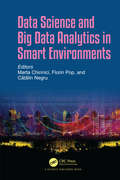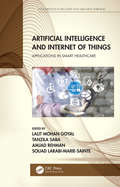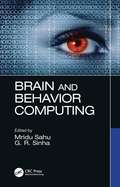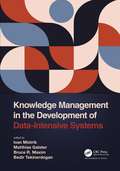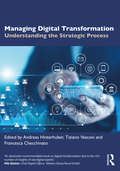- Table View
- List View
IP Routing Protocols: Fundamentals and Distance-Vector Routing Protocols
by James AweyaThis book focuses on the fundamental concepts of IP routing and distance-vector routing protocols (RIPv2 and EIGRP). It discusses routing protocols from a practicing engineer’s perspective, linking theory and fundamental concepts to common practices and everyday examples. The book benefits and reflects the author’s more than 22 years of designing and working with IP routing devices and protocols (and Telecoms systems, in general). Every aspect of the book is written to reflect current best practices using real-world examples. This book describes the various methods used by routers to learn routing information. The author includes discussion of the characteristics of the different dynamic routing protocols, and how they differ in design and operation. He explains the processing steps involved in forwarding IP packets through an IP router to their destination and discusses the various mechanisms IP routers use for controlling routing in networks. The discussion is presented in a simple style to make it comprehensible and appealing to undergraduate and graduate level students, research and practicing engineers, scientists, IT personnel, and network engineers. It is geared toward readers who want to understand the concepts and theory of IP routing protocols, through real-world example systems and networks. Focuses on the fundamental concepts of IP routing and distance-vector routing protocols (RIPv2 and EIGRP). Describes the various methods used by routers to learn routing information. Includes discussion of the characteristics of the different dynamic routing protocols, and how they differ in design and operation. Provides detailed descriptions of the most common distance-vector routing protocols RIPv2 and EIGRP. Discusses the various mechanisms IP routers use for controlling routing in networks. James Aweya, PhD, is a chief research scientist at the Etisalat British Telecom Innovation Center (EBTIC), Khalifa University, Abu Dhabi, UAE. He has authored four books including this book and is a senior member of the Institute of Electrical and Electronics Engineers (IEEE).
The Cloud Computing Book: The Future of Computing Explained
by Douglas ComerThis latest textbook from bestselling author, Douglas E. Comer, is a class-tested book providing a comprehensive introduction to cloud computing. Focusing on concepts and principles, rather than commercial offerings by cloud providers and vendors, The Cloud Computing Book: The Future of Computing Explained gives readers a complete picture of the advantages and growth of cloud computing, cloud infrastructure, virtualization, automation and orchestration, and cloud-native software design.The book explains real and virtual data center facilities, including computation (e.g., servers, hypervisors, Virtual Machines, and containers), networks (e.g., leaf-spine architecture, VLANs, and VxLAN), and storage mechanisms (e.g., SAN, NAS, and object storage). Chapters on automation and orchestration cover the conceptual organization of systems that automate software deployment and scaling. Chapters on cloud-native software cover parallelism, microservices, MapReduce, controller-based designs, and serverless computing. Although it focuses on concepts and principles, the book uses popular technologies in examples, including Docker containers and Kubernetes. Final chapters explain security in a cloud environment and the use of models to help control the complexity involved in designing software for the cloud.The text is suitable for a one-semester course for software engineers who want to understand cloud, and for IT managers moving an organization’s computing to the cloud.
The Cloud Computing Book: The Future of Computing Explained
by Douglas ComerThis latest textbook from bestselling author, Douglas E. Comer, is a class-tested book providing a comprehensive introduction to cloud computing. Focusing on concepts and principles, rather than commercial offerings by cloud providers and vendors, The Cloud Computing Book: The Future of Computing Explained gives readers a complete picture of the advantages and growth of cloud computing, cloud infrastructure, virtualization, automation and orchestration, and cloud-native software design.The book explains real and virtual data center facilities, including computation (e.g., servers, hypervisors, Virtual Machines, and containers), networks (e.g., leaf-spine architecture, VLANs, and VxLAN), and storage mechanisms (e.g., SAN, NAS, and object storage). Chapters on automation and orchestration cover the conceptual organization of systems that automate software deployment and scaling. Chapters on cloud-native software cover parallelism, microservices, MapReduce, controller-based designs, and serverless computing. Although it focuses on concepts and principles, the book uses popular technologies in examples, including Docker containers and Kubernetes. Final chapters explain security in a cloud environment and the use of models to help control the complexity involved in designing software for the cloud.The text is suitable for a one-semester course for software engineers who want to understand cloud, and for IT managers moving an organization’s computing to the cloud.
Radio, Public Life and Citizen Deliberation in South Africa (Routledge Contemporary South Africa)
by Sarah Chiumbu Gilbert MotsaathebeThis book critically analyses the important role of radio in public life in post-apartheid South Africa. As the most widespread and popular form of communication in the country, radio occupies an essential space in the deliberation and the construction of public opinion in South Africa. From just a few state-controlled stations during the apartheid era, there are now more than 100 radio stations, reaching vast swathes of the population and providing an important space for citizens to air their views and take part in significant socio-economic and political issues of the country. The various contributors to this book demonstrate that whilst print and television media often serve elite interests and audiences, the low cost and flexibility of radio has helped it to create a ‘common’ space for national dialogue and deliberation. The book also investigates the ways in which digital technologies have enhanced the consumption of radio and produced a sense of imagined community for citizens, including those in marginalised communities and rural areas. This book will be of interest to researchers with an interest in media, politics and culture in South Africa specifically, as well as those with an interest in broadcast media more generally.
Radio, Public Life and Citizen Deliberation in South Africa (Routledge Contemporary South Africa)
by Sarah ChiumbuThis book critically analyses the important role of radio in public life in post-apartheid South Africa. As the most widespread and popular form of communication in the country, radio occupies an essential space in the deliberation and the construction of public opinion in South Africa. From just a few state-controlled stations during the apartheid era, there are now more than 100 radio stations, reaching vast swathes of the population and providing an important space for citizens to air their views and take part in significant socio-economic and political issues of the country. The various contributors to this book demonstrate that whilst print and television media often serve elite interests and audiences, the low cost and flexibility of radio has helped it to create a ‘common’ space for national dialogue and deliberation. The book also investigates the ways in which digital technologies have enhanced the consumption of radio and produced a sense of imagined community for citizens, including those in marginalised communities and rural areas. This book will be of interest to researchers with an interest in media, politics and culture in South Africa specifically, as well as those with an interest in broadcast media more generally.
Force: Animal Locomotion and Design Concepts for Animators (Force Drawing Series)
by Mike MattesiThis 10th Anniversary Edition of Force: Animal Drawing: Animal Locomotion and Design Concepts for Animators offers readers an enlarged and an enhanced selection of images that apply FORCE to animals. With larger images, readers can better appreciate and learn how to bring their own animal illustrations to life. New drawings and facts about the animals create a more comprehensive edition for your library. Readers will also adapt key industry techniques that will help personify animal animations as well as endowing their creations with human-like expressions and unique animal movement. content can be found at DrawingFORCE.com Key Features: • This full-color 10th Anniversary Edition makes FORCE even easier to understand through great diagrams and illustrations • Color-coded page edges help you find more easily the animal you want to draw • Learn about key specifications for each mammal such as their weight range, food they eat, and how fast they run • Video content can be found at DrawingFORCE.com Mike Mattesi has authored four FORCE books, published in numerous languages and utilized around the world to inspire and educate artists on the concept of FORCE. He has instructed FORCE Drawing for more than twenty-five years and inspired thousands of artists. Simultaneously, he has been contributing his skills as a professional artist on numerous award-winning projects in varied capacities and has collaborated with Pixar, Walt Disney Feature Animation, Walt Disney Consumer Products, Marvel Comics, Hasbro Toys, ABC, Microsoft, Electronic Arts, DreamWorks/PDI, Zynga, the School of Visual Arts, Beijing University, Art Center, Scuola Internazionale di Comics, San Jose State University, the Academy of Art University, Nickelodeon, LeapFrog, and many others. His students occupy all fields of the art industry and have themselves gained prestige for their abilities. Visit Michael at DrawingFORCE.com; connect with him on Facebook at DrawingFORCE.com with Mike Mattesi and at Instagram @michaelmattesi; or email him directly at mike@drawingFORCE.com. Learn more about FORCE at: DrawingFORCE.com
Force: Animal Locomotion and Design Concepts for Animators (Force Drawing Series)
by Mike MattesiThis 10th Anniversary Edition of Force: Animal Drawing: Animal Locomotion and Design Concepts for Animators offers readers an enlarged and an enhanced selection of images that apply FORCE to animals. With larger images, readers can better appreciate and learn how to bring their own animal illustrations to life. New drawings and facts about the animals create a more comprehensive edition for your library. Readers will also adapt key industry techniques that will help personify animal animations as well as endowing their creations with human-like expressions and unique animal movement. content can be found at DrawingFORCE.com Key Features: • This full-color 10th Anniversary Edition makes FORCE even easier to understand through great diagrams and illustrations • Color-coded page edges help you find more easily the animal you want to draw • Learn about key specifications for each mammal such as their weight range, food they eat, and how fast they run • Video content can be found at DrawingFORCE.com Mike Mattesi has authored four FORCE books, published in numerous languages and utilized around the world to inspire and educate artists on the concept of FORCE. He has instructed FORCE Drawing for more than twenty-five years and inspired thousands of artists. Simultaneously, he has been contributing his skills as a professional artist on numerous award-winning projects in varied capacities and has collaborated with Pixar, Walt Disney Feature Animation, Walt Disney Consumer Products, Marvel Comics, Hasbro Toys, ABC, Microsoft, Electronic Arts, DreamWorks/PDI, Zynga, the School of Visual Arts, Beijing University, Art Center, Scuola Internazionale di Comics, San Jose State University, the Academy of Art University, Nickelodeon, LeapFrog, and many others. His students occupy all fields of the art industry and have themselves gained prestige for their abilities. Visit Michael at DrawingFORCE.com; connect with him on Facebook at DrawingFORCE.com with Mike Mattesi and at Instagram @michaelmattesi; or email him directly at mike@drawingFORCE.com. Learn more about FORCE at: DrawingFORCE.com
Computational Modeling and Data Analysis in COVID-19 Research (Emerging Trends in Biomedical Technologies and Health informatics)
by Chhabi Rani Panigrahi Bibudhendu Pati Mamata Rath Rajkumar BuyyaThis book covers recent research on the COVID-19 pandemic. It includes the analysis, implementation, usage, and proposed ideas and models with architecture to handle the COVID-19 outbreak. Using advanced technologies such as artificial intelligence (AI) and machine learning (ML), techniques for data analysis, this book will be helpful to mitigate exposure and ensure public health. We know prevention is better than cure, so by using several ML techniques, researchers can try to predict the disease in its early stage and develop more effective medications and treatments. Computational technologies in areas like AI, ML, Internet of Things (IoT), and drone technologies underlie a range of applications that can be developed and utilized for this purpose. Because in most cases there is no one solution to stop the spreading of pandemic diseases, and the integration of several tools and tactics are needed. Many successful applications of AI, ML, IoT, and drone technologies already exist, including systems that analyze past data to predict and conclude some useful information for controlling the spread of COVID-19 infections using minimum resources. The AI and ML approach can be helpful to design different models to give a predictive solution for mitigating infection and preventing larger outbreaks. This book: Examines the use of artificial intelligence (AI), machine learning (ML), Internet of Things (IoT), and drone technologies as a helpful predictive solution for controlling infection of COVID-19 Covers recent research related to the COVID-19 pandemic and includes the analysis, implementation, usage, and proposed ideas and models with architecture to handle a pandemic outbreak Examines the performance, implementation, architecture, and techniques of different analytical and statistical models related to COVID-19 Includes different case studies on COVID-19 Dr. Chhabi Rani Panigrahi is Assistant Professor in the Department of Computer Science at Rama Devi Women’s University, Bhubaneswar, India. Dr. Bibudhendu Pati is Associate Professor and Head of the Department of Computer Science at Rama Devi Women’s University, Bhubaneswar, India. Dr. Mamata Rath is Assistant Professor in the School of Management (Information Technology) at Birla Global University, Bhubaneswar, India. Prof. Rajkumar Buyya is a Redmond Barry Distinguished Professor and Director of the Cloud Computing and Distributed Systems (CLOUDS) Laboratory at the University of Melbourne, Australia.
Computational Modeling and Data Analysis in COVID-19 Research (Emerging Trends in Biomedical Technologies and Health informatics)
by Chhabi Rani Panigrahi, Bibudhendu Pati, Mamata Rath and Rajkumar BuyyaThis book covers recent research on the COVID-19 pandemic. It includes the analysis, implementation, usage, and proposed ideas and models with architecture to handle the COVID-19 outbreak. Using advanced technologies such as artificial intelligence (AI) and machine learning (ML), techniques for data analysis, this book will be helpful to mitigate exposure and ensure public health. We know prevention is better than cure, so by using several ML techniques, researchers can try to predict the disease in its early stage and develop more effective medications and treatments. Computational technologies in areas like AI, ML, Internet of Things (IoT), and drone technologies underlie a range of applications that can be developed and utilized for this purpose. Because in most cases there is no one solution to stop the spreading of pandemic diseases, and the integration of several tools and tactics are needed. Many successful applications of AI, ML, IoT, and drone technologies already exist, including systems that analyze past data to predict and conclude some useful information for controlling the spread of COVID-19 infections using minimum resources. The AI and ML approach can be helpful to design different models to give a predictive solution for mitigating infection and preventing larger outbreaks. This book: Examines the use of artificial intelligence (AI), machine learning (ML), Internet of Things (IoT), and drone technologies as a helpful predictive solution for controlling infection of COVID-19 Covers recent research related to the COVID-19 pandemic and includes the analysis, implementation, usage, and proposed ideas and models with architecture to handle a pandemic outbreak Examines the performance, implementation, architecture, and techniques of different analytical and statistical models related to COVID-19 Includes different case studies on COVID-19 Dr. Chhabi Rani Panigrahi is Assistant Professor in the Department of Computer Science at Rama Devi Women’s University, Bhubaneswar, India. Dr. Bibudhendu Pati is Associate Professor and Head of the Department of Computer Science at Rama Devi Women’s University, Bhubaneswar, India. Dr. Mamata Rath is Assistant Professor in the School of Management (Information Technology) at Birla Global University, Bhubaneswar, India. Prof. Rajkumar Buyya is a Redmond Barry Distinguished Professor and Director of the Cloud Computing and Distributed Systems (CLOUDS) Laboratory at the University of Melbourne, Australia.
Artificial Intelligence in Cultural Production: Critical Perspectives on Digital Platforms (Routledge Studies in New Media and Cyberculture)
by Dal Yong JinThis book offers an in-depth academic discourse on the convergence of AI, digital platforms, and popular culture, in order to understand the ways in which the platform and cultural industries have reshaped and developed AI-driven algorithmic cultural production and consumption. At a time of fundamental change for the media and cultural industries, driven by the emergence of big data, algorithms, and AI, the book examines how media ecology and popular culture are evolving to serve the needs of both media and cultural industries and consumers. The analysis documents global governments’ rapid development of AI-relevant policies and identifies key policy issues; examines the ways in which cultural industries firms utilize AI and algorithms to advance the new forms of cultural production and distribution; investigates change in cultural consumption by analyzing the ways in which AI, algorithms, and digital platforms reshape people’s consumption habits; and examines whether governments and corporations have advanced reliable public and corporate policies and ethical codes to secure socio-economic equality. Offering a unique perspective on this timely and vital issue, this book will be of interest to scholars and students in media studies, communication studies, anthropology, globalization studies, sociology, cultural studies, Asian studies, and science and technology studies (STS).
Artificial Intelligence in Cultural Production: Critical Perspectives on Digital Platforms (Routledge Studies in New Media and Cyberculture)
by Dal Yong JinThis book offers an in-depth academic discourse on the convergence of AI, digital platforms, and popular culture, in order to understand the ways in which the platform and cultural industries have reshaped and developed AI-driven algorithmic cultural production and consumption. At a time of fundamental change for the media and cultural industries, driven by the emergence of big data, algorithms, and AI, the book examines how media ecology and popular culture are evolving to serve the needs of both media and cultural industries and consumers. The analysis documents global governments’ rapid development of AI-relevant policies and identifies key policy issues; examines the ways in which cultural industries firms utilize AI and algorithms to advance the new forms of cultural production and distribution; investigates change in cultural consumption by analyzing the ways in which AI, algorithms, and digital platforms reshape people’s consumption habits; and examines whether governments and corporations have advanced reliable public and corporate policies and ethical codes to secure socio-economic equality. Offering a unique perspective on this timely and vital issue, this book will be of interest to scholars and students in media studies, communication studies, anthropology, globalization studies, sociology, cultural studies, Asian studies, and science and technology studies (STS).
Data Science and Big Data Analytics in Smart Environments
by Marta Chinnici Florin Pop Catalin NegruMost applications generate large datasets, like social networking and social influence programs, smart cities applications, smart house environments, Cloud applications, public web sites, scientific experiments and simulations, data warehouse, monitoring platforms, and e-government services. Data grows rapidly, since applications produce continuously increasing volumes of both unstructured and structured data. Large-scale interconnected systems aim to aggregate and efficiently exploit the power of widely distributed resources. In this context, major solutions for scalability, mobility, reliability, fault tolerance and security are required to achieve high performance and to create a smart environment. The impact on data processing, transfer and storage is the need to re-evaluate the approaches and solutions to better answer the user needs. A variety of solutions for specific applications and platforms exist so a thorough and systematic analysis of existing solutions for data science, data analytics, methods and algorithms used in Big Data processing and storage environments is significant in designing and implementing a smart environment.Fundamental issues pertaining to smart environments (smart cities, ambient assisted leaving, smart houses, green houses, cyber physical systems, etc.) are reviewed. Most of the current efforts still do not adequately address the heterogeneity of different distributed systems, the interoperability between them, and the systems resilience. This book will primarily encompass practical approaches that promote research in all aspects of data processing, data analytics, data processing in different type of systems: Cluster Computing, Grid Computing, Peer-to-Peer, Cloud/Edge/Fog Computing, all involving elements of heterogeneity, having a large variety of tools and software to manage them. The main role of resource management techniques in this domain is to create the suitable frameworks for development of applications and deployment in smart environments, with respect to high performance. The book focuses on topics covering algorithms, architectures, management models, high performance computing techniques and large-scale distributed systems.
Data Science and Big Data Analytics in Smart Environments
by Marta Chinnici; Florin Pop; Cătălin NegruMost applications generate large datasets, like social networking and social influence programs, smart cities applications, smart house environments, Cloud applications, public web sites, scientific experiments and simulations, data warehouse, monitoring platforms, and e-government services. Data grows rapidly, since applications produce continuously increasing volumes of both unstructured and structured data. Large-scale interconnected systems aim to aggregate and efficiently exploit the power of widely distributed resources. In this context, major solutions for scalability, mobility, reliability, fault tolerance and security are required to achieve high performance and to create a smart environment. The impact on data processing, transfer and storage is the need to re-evaluate the approaches and solutions to better answer the user needs. A variety of solutions for specific applications and platforms exist so a thorough and systematic analysis of existing solutions for data science, data analytics, methods and algorithms used in Big Data processing and storage environments is significant in designing and implementing a smart environment.Fundamental issues pertaining to smart environments (smart cities, ambient assisted leaving, smart houses, green houses, cyber physical systems, etc.) are reviewed. Most of the current efforts still do not adequately address the heterogeneity of different distributed systems, the interoperability between them, and the systems resilience. This book will primarily encompass practical approaches that promote research in all aspects of data processing, data analytics, data processing in different type of systems: Cluster Computing, Grid Computing, Peer-to-Peer, Cloud/Edge/Fog Computing, all involving elements of heterogeneity, having a large variety of tools and software to manage them. The main role of resource management techniques in this domain is to create the suitable frameworks for development of applications and deployment in smart environments, with respect to high performance. The book focuses on topics covering algorithms, architectures, management models, high performance computing techniques and large-scale distributed systems.
Artificial Intelligence and Internet of Things: Applications in Smart Healthcare (Innovations in Big Data and Machine Learning)
by Lalit Mohan Goyal Tanzila Saba Amjad Rehman Souad Larabi-Marie-SainteThis book reveals the applications of AI and IoT in smart healthcare and medical systems. It provides core principles, algorithms, protocols, emerging trends, security problems, and the latest e-healthcare services findings.The book also provides case studies and discusses how AI and IoT applications such as wireless devices, sensors, and deep learning could play a major role in assisting patients, doctors, and pharmaceutical staff. It focuses on how to use AI and IoT to keep patients safe and healthy and, at the same time, empower physicians to deliver superlative care.This book is written for researchers and practitioners working in the information technology, computer science, and medical equipment manufacturing industry for products and services having basic- and high-level AI and IoT applications. The book is also a useful guide for academic researchers and students.
Creating Brand Cool: Brand Distinction in the Online Marketplace
by Joan AbrahamIn this intriguing blend of branding how-to and business memoir, an industry pioneer presents the thought process and tools to create a successful Ecommerce business by developing a distinct emotional attraction to a brand, beyond individual product offerings. Leveraging her 26 years of experience in online marketing and branding, Joan Abraham reveals the thought process behind successfully addressing today’s marketing challenge: clearly defining the business’s brand essence using its owned social media channels to personalize the full character of the brand. Creating Brand Cool addresses the importance of developing a unique state of being that personally resonates with today’s consumer. Abraham energizes the creative and strategic thinking for attracting and maintaining brand loyalty when the competition is a click away. Appealing to branding and social media marketing professionals, as well as students in these fields, this book is a primer for building an online community and distinguishing a brand from the competition. It is relevant to all types of business, from small businesses to globally recognized brands.
Artificial Intelligence and Internet of Things: Applications in Smart Healthcare (Innovations in Big Data and Machine Learning)
by Lalit Mohan GoyalThis book reveals the applications of AI and IoT in smart healthcare and medical systems. It provides core principles, algorithms, protocols, emerging trends, security problems, and the latest e-healthcare services findings.The book also provides case studies and discusses how AI and IoT applications such as wireless devices, sensors, and deep learning could play a major role in assisting patients, doctors, and pharmaceutical staff. It focuses on how to use AI and IoT to keep patients safe and healthy and, at the same time, empower physicians to deliver superlative care.This book is written for researchers and practitioners working in the information technology, computer science, and medical equipment manufacturing industry for products and services having basic- and high-level AI and IoT applications. The book is also a useful guide for academic researchers and students.
Creating Brand Cool: Brand Distinction in the Online Marketplace
by Joan AbrahamIn this intriguing blend of branding how-to and business memoir, an industry pioneer presents the thought process and tools to create a successful Ecommerce business by developing a distinct emotional attraction to a brand, beyond individual product offerings. Leveraging her 26 years of experience in online marketing and branding, Joan Abraham reveals the thought process behind successfully addressing today’s marketing challenge: clearly defining the business’s brand essence using its owned social media channels to personalize the full character of the brand. Creating Brand Cool addresses the importance of developing a unique state of being that personally resonates with today’s consumer. Abraham energizes the creative and strategic thinking for attracting and maintaining brand loyalty when the competition is a click away. Appealing to branding and social media marketing professionals, as well as students in these fields, this book is a primer for building an online community and distinguishing a brand from the competition. It is relevant to all types of business, from small businesses to globally recognized brands.
Brain and Behavior Computing
by Mridu Sahu G. R. SinhaBrain and Behavior Computing offers insights into the functions of the human brain. This book provides an emphasis on brain and behavior computing with different modalities available such as signal processing, image processing, data sciences, statistics further it includes fundamental, mathematical model, algorithms, case studies, and future research scopes. It further illustrates brain signal sources and how the brain signal can process, manipulate, and transform in different domains allowing researchers and professionals to extract information about the physiological condition of the brain. Emphasizes real challenges in brain signal processing for a variety of applications for analysis, classification, and clustering. Discusses data sciences and its applications in brain computing visualization. Covers all the most recent tools for analysing the brain and it’s working. Describes brain modeling and all possible machine learning methods and their uses. Augments the use of data mining and machine learning to brain computer interface (BCI) devices. Includes case studies and actual simulation examples. This book is aimed at researchers, professionals, and graduate students in image processing and computer vision, biomedical engineering, signal processing, and brain and behavior computing.
Brain and Behavior Computing
by Mridu SahuBrain and Behavior Computing offers insights into the functions of the human brain. This book provides an emphasis on brain and behavior computing with different modalities available such as signal processing, image processing, data sciences, statistics further it includes fundamental, mathematical model, algorithms, case studies, and future research scopes. It further illustrates brain signal sources and how the brain signal can process, manipulate, and transform in different domains allowing researchers and professionals to extract information about the physiological condition of the brain. Emphasizes real challenges in brain signal processing for a variety of applications for analysis, classification, and clustering. Discusses data sciences and its applications in brain computing visualization. Covers all the most recent tools for analysing the brain and it’s working. Describes brain modeling and all possible machine learning methods and their uses. Augments the use of data mining and machine learning to brain computer interface (BCI) devices. Includes case studies and actual simulation examples. This book is aimed at researchers, professionals, and graduate students in image processing and computer vision, biomedical engineering, signal processing, and brain and behavior computing.
Recommender Systems: Algorithms and Applications
by Sachi Nandan Mohanty P. Pavan Kumar S. Vairachilai Sirisha PotluriRecommender systems use information filtering to predict user preferences. They are becoming a vital part of e-business and are used in a wide variety of industries, ranging from entertainment and social networking to information technology, tourism, education, agriculture, healthcare, manufacturing, and retail. Recommender Systems: Algorithms and Applications dives into the theoretical underpinnings of these systems and looks at how this theory is applied and implemented in actual systems. The book examines several classes of recommendation algorithms, including Machine learning algorithms Community detection algorithms Filtering algorithms Various efficient and robust product recommender systems using machine learning algorithms are helpful in filtering and exploring unseen data by users for better prediction and extrapolation of decisions. These are providing a wider range of solutions to such challenges as imbalanced data set problems, cold-start problems, and long tail problems. This book also looks at fundamental ontological positions that form the foundations of recommender systems and explain why certain recommendations are predicted over others. Techniques and approaches for developing recommender systems are also investigated. These can help with implementing algorithms as systems and include A latent-factor technique for model-based filtering systems Collaborative filtering approaches Content-based approaches Finally, this book examines actual systems for social networking, recommending consumer products, and predicting risk in software engineering projects.
Big Data and Artificial Intelligence for Healthcare Applications (Big Data for Industry 4.0)
by Ankur Saxena Nicolas Brault Shazia RashidThis book covers a wide range of topics on the role of Artificial Intelligence, Machine Learning, and Big Data for healthcare applications and deals with the ethical issues and concerns associated with it. This book explores the applications in different areas of healthcare and highlights the current research. The book covers healthcare big data analytics, mobile health and personalized medicine, clinical trial data management and presents how Artificial Intelligence can be used for early disease diagnosis prediction and prognosis. It also offers some case studies that describes the application of Artificial Intelligence and Machine Learning in healthcare. This book will be useful for researchers, healthcare professionals, data scientists, systems engineers, students, programmers, clinicians, and policymakers.
Big Data and Artificial Intelligence for Healthcare Applications (Big Data for Industry 4.0)
by Ankur Saxena, Nicolas Brault, and Shazia RashidThis book covers a wide range of topics on the role of Artificial Intelligence, Machine Learning, and Big Data for healthcare applications and deals with the ethical issues and concerns associated with it. This book explores the applications in different areas of healthcare and highlights the current research. The book covers healthcare big data analytics, mobile health and personalized medicine, clinical trial data management and presents how Artificial Intelligence can be used for early disease diagnosis prediction and prognosis. It also offers some case studies that describes the application of Artificial Intelligence and Machine Learning in healthcare. This book will be useful for researchers, healthcare professionals, data scientists, systems engineers, students, programmers, clinicians, and policymakers.
Recommender Systems: Algorithms and Applications
by Sachi Nandan Mohanty P. Pavan Kumar S. Vairachilai Sirisha PotluriRecommender systems use information filtering to predict user preferences. They are becoming a vital part of e-business and are used in a wide variety of industries, ranging from entertainment and social networking to information technology, tourism, education, agriculture, healthcare, manufacturing, and retail. Recommender Systems: Algorithms and Applications dives into the theoretical underpinnings of these systems and looks at how this theory is applied and implemented in actual systems. The book examines several classes of recommendation algorithms, including Machine learning algorithms Community detection algorithms Filtering algorithms Various efficient and robust product recommender systems using machine learning algorithms are helpful in filtering and exploring unseen data by users for better prediction and extrapolation of decisions. These are providing a wider range of solutions to such challenges as imbalanced data set problems, cold-start problems, and long tail problems. This book also looks at fundamental ontological positions that form the foundations of recommender systems and explain why certain recommendations are predicted over others. Techniques and approaches for developing recommender systems are also investigated. These can help with implementing algorithms as systems and include A latent-factor technique for model-based filtering systems Collaborative filtering approaches Content-based approaches Finally, this book examines actual systems for social networking, recommending consumer products, and predicting risk in software engineering projects.
Knowledge Management in the Development of Data-Intensive Systems
by Ivan Mistrik Matthias Galster Bruce R. Maxim Bedir TekinerdoganData-intensive systems are software applications that process and generate Big Data. Data-intensive systems support the use of large amounts of data strategically and efficiently to provide intelligence. For example, examining industrial sensor data or business process data can enhance production, guide proactive improvements of development processes, or optimize supply chain systems. Designing data-intensive software systems is difficult because distribution of knowledge across stakeholders creates a symmetry of ignorance, because a shared vision of the future requires the development of new knowledge that extends and synthesizes existing knowledge. Knowledge Management in the Development of Data-Intensive Systems addresses new challenges arising from knowledge management in the development of data-intensive software systems. These challenges concern requirements, architectural design, detailed design, implementation and maintenance. The book covers the current state and future directions of knowledge management in development of data-intensive software systems. The book features both academic and industrial contributions which discuss the role software engineering can play for addressing challenges that confront developing, maintaining and evolving systems;data-intensive software systems of cloud and mobile services; and the scalability requirements they imply. The book features software engineering approaches that can efficiently deal with data-intensive systems as well as applications and use cases benefiting from data-intensive systems. Providing a comprehensive reference on the notion of data-intensive systems from a technical and non-technical perspective, the book focuses uniquely on software engineering and knowledge management in the design and maintenance of data-intensive systems. The book covers constructing, deploying, and maintaining high quality software products and software engineering in and for dynamic and flexible environments. This book provides a holistic guide for those who need to understand the impact of variability on all aspects of the software life cycle. It leverages practical experience and evidence to look ahead at the challenges faced by organizations in a fast-moving world with increasingly fast-changing customer requirements and expectations.
Managing Digital Transformation: Understanding the Strategic Process
by Andreas Hinterhuber Tiziano Vescovi Francesca ChecchinatoThis book provides practising executives and academics with the theories and best practices to plan and implement the digital transformation successfully. Key benefits: an overview on how leading companies plan and implement digital transformation interviews with chief executive officers and chief digital officers of leading companies – Bulgari, Deutsche Bahn, Henkel, Lanxess, L’Oréal, Unilever, Thales and others – explore lessons learnt and roadmaps to successful implementation research and case studies on the digitalization of small and medium-sized companies cutting-edge academic research on business models, organizational capabilities and performance implications of the digital transformation tools and insights into how to overcome internal resistance, build digital capabilities, align the organization, develop the ecosystem and create customer value to implement digital strategies that increase profits Managing Digital Transformation is unique in its approach, combining rigorous academic theory with practical insights and contributions from companies that are, according to leading academic thinkers, at the forefront of global best practice in the digital transformation. It is a recommended reading both for practitioners looking to implement digital strategies within their own organisations, as well as for academics and postgraduate students studying digital transformation, strategy and marketing.
